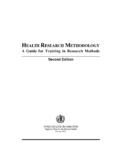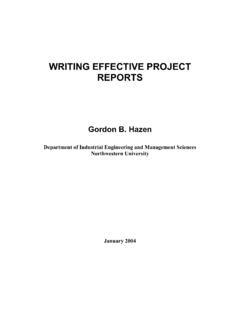Transcription of WINTER TIRES: A REVIEW OF RESEARCH ON …
1 WINTER TIRES: A REVIEW OF RESEARCH ON effectiveness AND USETRaffIc INjuRy RESEARCH fouNdaTIoNThe knowledge source for safe drivingThe Traffic Injury RESEARCH foundationThe mission of the Traffic Injury RESEARCH Foundation (TIRF) is to reduce traffic-related deaths and injuries. TIRF is an independent, charitable road safety institute. Since its inception in 1964, TIRF has become internationally recognized for its accomplishments in identifying the causes of road crashes and developing program and policies to address them Injury RESEARCH Foundation 171 Nepean St. Suite 200 Ottawa, ON K2P 0B4 Ph: (613)238-5235 Fax: (613)238-5292 Email: February 2012 Traffic Injury RESEARCH Foundation Copyright 2012 ISBN: 978-1-926857-26-8 WINTER TIRES: a REVIEW of RESEARCH oN effectiveness aNd uSESteve W. Brown / Ward Vanlaar / Robyn D. RobertsonTraffic Injury RESEARCH FoundationWINTER TIRES | A REVIEW OF RESEARCH ON effectiveness AND USEiiiTablE of coNTENTSEXECUTIVE SUMMARY VINTRODUCTION 1 METHOD 4 TYPE OF TIRES 6 Summer Tires.
2 6 All-Season Tires ..6 All-Weather Tires ..6 WINTER Tires ..7 Studded of Types of Tires ..8 LITERATURE REVIEW 9 Experimental Studies and Demonstrations ..9 Epidemiological Collision Studies ..14 Literature Reviews ..16 Public Opinion Polls ..17 Websites, Bulletins, Newsletters, Newspapers and Magazine Articles ..19 Summary of Literature REVIEW ..19 LIMITATIONS 20 Outdated Nature of RESEARCH Materials ..20 Limited Data Comparability and Compatibility ..20 Gaps in Data Collection ..21 Inattention to WINTER Tire Issue ..22 Proprietary Nature of RESEARCH ..22 WINTER TIRE INITIATIVES 23 National Initiatives.
3 23 Provincial Initiatives ..23 CONCLUSIONS 28 RECOMMENDATIONS 30 REFERENCES 32 APPENDIX 1 40 WINTER TIRES | A REVIEW OF RESEARCH ON effectiveness AND USEvEXEcuTIVE SuMMaRy A significant number of people are killed and injured in road crashes in Canada each year. Not surprisingly, this is a leading cause for public concern and efforts are needed to mitigate crashes. One mitigation strategy that is garnering more attention is the use of WINTER tires to reduce WINTER crashes and improve driver safety in a wide range of WINTER road conditions.
4 Available information about this topic suggests that WINTER tires improve acceleration, handling and braking of vehicles in WINTER conditions ( , wet, slushy, snowy, icy and dry cold surfaces). However, generally speaking, many drivers in Canada do not use WINTER tires, for a variety of reasons. It is not clear whether or not increased use of WINTER tires has had an impact on the number of crashes, injuries and Traffic Injury RESEARCH Foundation (TIRF) was contracted by the WINTER Driving Safety Coalition comprised of the Canadian Automobile Association South Central Office, Ontario Safety League, Rubber Association of Canada, Ontario Hospital Association and Canadian Tire to REVIEW the literature on WINTER tires and safe WINTER driving. The objective of this work was to compile and REVIEW available information and develop a current state of knowledge regarding the efficacy of WINTER tires and their potential effects on traffic safety, within the broader context of safe WINTER driving strategies.
5 This was pursued using a thorough REVIEW and analysis of existing domestic and international RESEARCH and an environmental scan for relevant WINTER tire REVIEW also provided insights into the strengths and weaknesses of the existing body of RESEARCH about WINTER tires. Several weaknesses were identified, including:> Outdated nature of RESEARCH materials;> Limited data comparability and compatibility;> Gaps in data collection;> Inattention to the WINTER tire issue; and,> Proprietary nature of overview of WINTER tire initiatives at three levels in Canada was also provided, including the national and provincial level as well as industry level on the available information from experimental studies and demonstration projects it appears that in WINTER driving conditions, WINTER tires outperform other types of tires, notably all-season tires and summer tires. Also, based on available public opinion RESEARCH about WINTER tire usage, it appears the public does not fully appreciate the benefits of WINTER tires, suggesting education may be beneficial.
6 However, despite the apparent advantages of using WINTER tires, the RESEARCH available about this topic is outdated and fairly WINTER TIRES | A REVIEW OF RESEARCH ON effectiveness AND USEvilimited. More precisely, there is an insufficient body of literature, especially in terms of epidemiological collision studies to validate the limited experimental findings in that it is not clear how these experimental findings carry over into the real world. More precisely, the question whether this apparent advantage of superior performance of WINTER tires in WINTER conditions translates into fewer collisions, injuries and fatalities remains largely unanswered. The issue is compounded by the fast and continuous improvements to WINTER tire technology in recent years. While more studies focusing on the effectiveness of modern WINTER tires may become available, findings can still be considered limited and more RESEARCH is needed to better understand how this new technology can help improve traffic safety.
7 As it stands today, more RESEARCH would be beneficial to further inform sound is also important to recognize that proper use of WINTER tires is only one aspect of safe WINTER driving. There are many other aspects that are important including overall vehicle preparedness and defensive driving techniques. While such aspects were beyond the scope of this report, the findings described in this report are not meant to, and therefore must not be used to limit the discussion of safe WINTER driving to the use of WINTER tires on the findings from this study, recommendations regarding follow-up RESEARCH and public education were TIRES | A REVIEW OF RESEARCH ON effectiveness AND USE1 INTR oducTIoNA significant number of people are killed and injured in road crashes in Canada each year. Not surprisingly, this is a leading cause for public concern and efforts are needed to mitigate crashes. One mitigation strategy that is garnering more attention is the use of WINTER tires to reduce WINTER crashes and improve driver safety in a wide range of WINTER road conditions.
8 Studies suggest that WINTER tires improve acceleration, handling and braking of vehicles in WINTER conditions ( , wet, slushy, snowy, icy and dry cold surfaces). However, in an online poll conducted among Ontario drivers by Ipsos Reid for Canadian Tire, only 47% of respondents claimed that they used WINTER tires (Ipsos Reid 2010). Despite the apparent advantages, there are obstacles to increased WINTER tire use. They are perceived to cost more than other types of tires. Some consumers believe that WINTER tires have a higher rolling resistance coefficient and, as a consequence, offer less fuel economy. And there are those who do not intend to use WINTER tires for a variety of reasons including a lack of storage room for another set of tires, a belief that their regular tires are satisfactory, and that their roads are well-maintained or their region does not receive much snow (Ipsos Reid 2010).Estimates of the extent of crashes resulting from weather-related collisions generally or WINTER conditions specifically provide some insight into the magnitude of the problem and its costs.
9 Nationally, using aggregate risk and cost data, it was estimated that weather-related collisions in Canada cost $ billion per year (Andrey and Mills 2003), and among these collisions are those that occur in WINTER conditions. Provincial measures from the Royal Canadian Mounted Police (RCMP) in British Columbia claim that the fall and WINTER seasons are when motorists are most inclined to speed and drive too fast for road conditions and that 44% of casualty collisions can be attributed to these factors (British Columbia RCMP 2010). More recently, over a five-year period, Aviva Canada reported a 49% increase in customer auto claims between December and February in comparison to the rest of the year (Aviva Canada 2011). Among overseas studies, the United Kingdom (UK) Department for Transport statistics reported that in 2003, 48% of collisions are caused by skidding during WINTER conditions, as opposed to 11% during dry conditions and 19% during wet conditions (eTyres 2004).
10 Among Canadian jurisdictions, Quebec is the only jurisdiction that has mandatory WINTER tire legislation throughout its borders and in British Columbia, vehicles must be equipped with WINTER tires or the operator must carry chains to be permitted access on designated roads (principally in mountainous terrain). As of January 2010, several European countries with winters comparable to Canada made WINTER tires mandatory; these countries include Sweden, Estonia, Finland, Romania, and Slovenia. In Austria, Latvia, Norway and Slovakia, WINTER tires are required if weather conditions are adverse. Other countries such as WINTER TIRES | A REVIEW OF RESEARCH ON effectiveness AND USE2 France, Spain and the Czech Republic require WINTER tires only where a specific road sign indicates the need for such tires (ECC Net 2010).Generally speaking, there has been a gradual increase in the number of Canadian drivers choosing to use WINTER tires. A 2002 study showed that an average of 42% of Canadian drivers switched tires in the WINTER months, ranging from 30% among Prairie drivers to 60% of Quebec drivers (CBC 2006).








